We’re living in a time of artistic rediscovery. Frequently, the narrative goes like this: curators dig deep into their institutional collections and find that they hold a work (or, sometimes, many works) by an artist who was never really given their due. This artist, who ran with a popular 20th century crowd, was a crucial part of their artistic movement and contributed just as much as the individuals who are heralded as “masters” of modern art, Surrealism, Ab-Ex, etc. Then, the curators, who are continuously looking for ways to broaden the canon and make their mark (and, presumably, who are trying to avoid a rehash of shows that have already happened over the past 50 years), dig around to see where this person’s art actually is. This is a lengthy process, but the result is fruitful: a show that makes us reexamine an artist we didn’t know that we didn’t know.
A significant number of these recent shows have featured pre- and post-war artists. Francis Picabia, though not overlooked in the traditional sense, was an artist whose work, when seen one piece at a time, could be rather easy to dismiss. His 2016 retrospective at MoMA, however, got the critics and curators talking. The show, which was huge and varied (if you hadn’t been paying attention, you could’ve easily thought it was a group exhibition), showed Picabia in a new light. He wasn’t just a Dada leader — rather, he was an artist who bucked any semblance of classification. Similarly, the Guggenheim’s lauded 2019 Hilma af Klint show was a reconsideration of an artist who had been more or less invisible both to the public and the larger art world. This show was, I’d say, more groundbreaking than Picabia’s; at least Picabia had a sparse painting or two up in major museums.
Many of the artists featured in these types of exhibitions haven’t been considered widely or reassessed in the contemporary era. This too was the case with Sophie Taeuber-Arp, the spouse of Hans/Jean Arp, whose most recent major U.S. show had been nearly 40 years ago. Just last year, MoMA opened Sophie Taeuber-Arp: Living Abstraction, a new exploration of the artist’s life and work.
I see it as no coincidence that Anne Umland, MoMA’s Blanchette Hooker Rockefeller Senior Curator of Painting and Sculpture, organized both the Picabia and the Taeuber-Arp exhibitions. It is not surprising, in this case, that Umland also has a hand in this spring and summer’s best show in Houston: Meret Oppenheim: My Exhibition at the Menil Collection.
Co-curated by Umland from MoMA, Natalie Dupêcher from the Menil, and Nina Zimmer, from the Kunstmuseum Bern / Zentrum Paul Klee, the exhibition offers a top-down overhaul of any perceptions you had about Oppenheim’s career. While her name may be familiar to art history undergrads (her Object, a fur-covered teacup, saucer, and spoon, tends to make an appearance in survey textbooks), oftentimes the recognition stops there. And although this piece has defined the Surrealist movement ever since it was first shown (it is not on view in the Houston stop of the exhibition, as like some of Oppenheim’s other works it is too fragile to travel), it also pigeonholed Oppenheim’s talent.

Meret Oppenheim, “Object,” 1936, fur-covered cup, saucer, and spoon, cup 4 3/8 inches in diameter; saucer 9 3/8 inches in diameter; spoon 8 inches long, overall height 2 7/8 inches. Collection of the Museum of Modern Art, New York. © 2022 Artists Rights Society (ARS), New York / Pro Litteris, Zurich
The artist was conscious of this when MoMA purchased the work in 1936, when she was only 22 years old; she didn’t want to become “the fur artist.” To counter this, she pushed her output further, moving out of the Surrealist movement and modernism entirely, until she reached a sort of making that was based in conceptualism: have an idea, and form will follow. She also kept a firm grip on her own narrative: she wrote letters voraciously, including her thoughts and opinions about art and other topics, and also annotated her press clippings and interviews, seeking to set records straight. Notably, because she considered herself an artist not limited by gender or artistic generation, she declined to be interviewed for a book on women Surrealist artists.
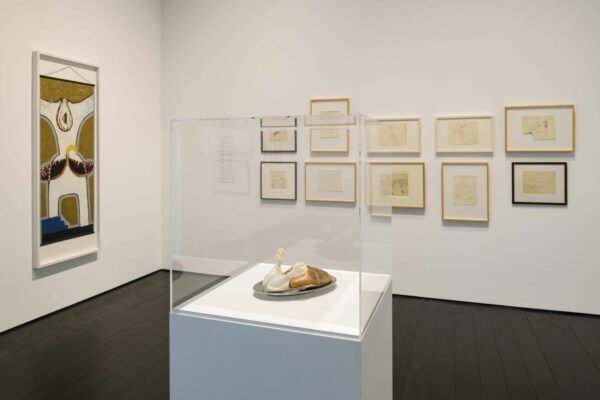
Installation view of “Meret Oppenheim: My Exhibition” at the Menil Collection, Houston. Photo by Paul Hester
In line with Oppenheim’s view of her life, My Exhibition offers more than delayed recognition of an undersung woman artist. Instead, it is an upending of pre- and misconceptions about who she was and what she stood for, and a lesson that one work does not an artist make.

Meret Oppenheim, “Ma gouvernante – My Nurse – Mein Kindermädchen,” 1936/1967, metal plate, shoes, string, and paper, 5 1/2 x 13 x 8 1/4 inches (14 x 33 x 21 cm). Moderna Museet, Stockholm. © Artists Rights Society (ARS), New York / Pro Litteris, Zurich
Similar to Picabia’s show, the stylistic diversity of the art in My Exhibition is remarkable. At the Menil, visitors are greeted by a room of early works that form the springboard for Oppenheim’s career. These 1930s (teacup-era) pieces immediately satisfy what we’ve be conditioned to look for in a show of the artist’s work. Two sculptures flank the entering viewer: on the left, a pair of high heels sit upside down and tied together. Each stiletto wears a turkey frill, and the whole of the work, quite convincingly, emulates a trussed chicken. On the right is Fur Gloves with Wooden Fingers, which, as its title suggests, is a marriage of human and beast. The sculpture retains a biting femininity, which is a through line in Oppenheim’s career, and is contradictorily both erotic and unsettling.
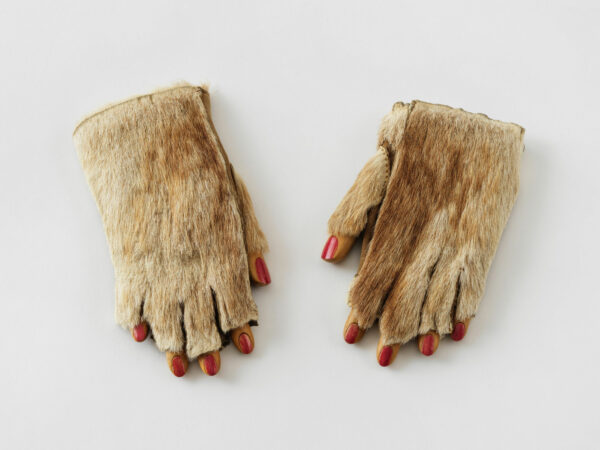
Meret Oppenheim, “Fur Gloves with Wooden Fingers (Pelzhandschuhe),” 1936, fur, wood, and nail polish, 2 x 8 1/4 x 3 7/8 inches (5 x 21 x 10 cm). Ursula Hauser Collection, Switzerland. © Artists Rights Society (ARS), New York / Pro Litteris, Zurich
Because the pieces in this room are early, in them you can see Oppenheim working it out. Whether purposeful or not, there are elements of Constructivism, Surrealism, mysticism, and expressionism. Votive Picture (Strangling Angel), a watercolor made in 1931, when the artist would have been about 18, shows an elegantly dressed woman holding a bleeding child. The double-peaked hill behind her alludes to a pair of breasts, and in the foreground we see that she appears to be standing on three other women, represented by upturned legs topped off with high heels. The painting shares qualities with the work of George Grosz and Ernst Ludwig Kirchner; it has a caricatured roughness and a violence about it, while also maintaining a healthy dose of black comedy.
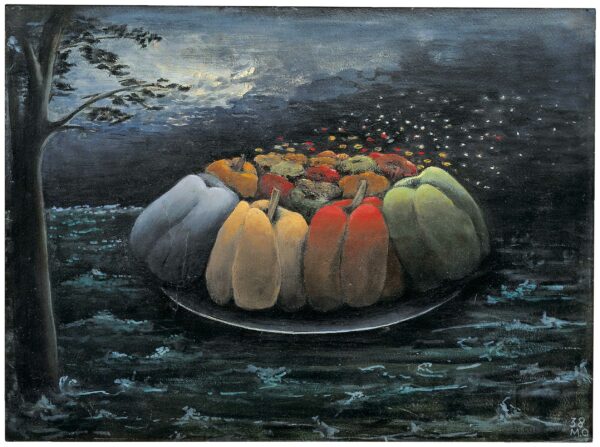
Meret Oppenheim, “Sweet Peppers on the Water (Peperoni auf dem Wasser),” 1938, oil on cardboard, 17 1/8 × 23 7/16 inches (43.5 × 59.5 cm). Kunstmuseum Solothurn, Switzerland. Lilian Benziger-Schild and Alfred Benziger Bequest. © Artists Rights Society (ARS), New York / Pro Litteris, Zurich
Paintings in the exhibition’s second gallery move into the surreal and the mystical. As World War II approached, Oppenheim left Paris, where she had lived since 1932, to return home to Switzerland. There, while stationed at her great grandparents’ house in Basel, she began to take painting classes at a local trade school. Works like Sweet Peppers on the Water are the result of the artist’s newfound medium and talent. In this properly bizarre still life, the world is not as we know it: peppers are either shedding their leaves into the wind or migrating to the foreground, eager to be a part of the display, which is hovering over a churning black ocean. A tree grows out of the water on the left side of the picture, unmoored to any landmass. As a whole, the composition and palette are fantastic, and are uniquely Oppenheim’s.

Meret Oppenheim, “The Suffering of Genevieve (Das Leiden der Genoveva),” 1939, oil on canvas, 19 1/2 × 28 1/8 inches (49.4 × 71.5 cm). Kunstmuseum Bern. Meret Oppenheim Bequest. © Artists Rights Society (ARS), New York / Pro Litteris, Zurich
Other pieces from this period have a more anchored surrealist bent. Stone Woman (1938) is a reimagining of a Man Ray photograph from 1933, while Rhine Landscape (1941) has a Max Ernst feel. The Suffering of Genevieve (1939), which is one of Oppenheim’s early depictions of the High Middle Ages legend of the exiled noblewoman (a subject she returned to throughout her career), has a Henri Rousseau mood. However, whatever stylistic nods may be present, she has taken the subject and run with it. Rather than depicting the exiled woman waiting in a pasture or a cave, Oppenheim paints Genevieve nude, hovering over a forest landscape, with a town in the background. While the composition is fairly simple, there’s much to discover, including a small, speckled, spiky-headed imp-like creature that rides overhead in a broken wagon filled with roses.
This early depiction of the Genevieve myth is significant, as it kicks off the artist’s lifelong kinship with the legend’s namesake. According to the exhibition’s catalog: “Just as the innocent noblewoman [Genevieve] had to flee the castle [after being falsely accused of infidelity by her husband, a high-ranking court official], the artist had been forced to leave Paris and her circle of friends when it became clear that World War II was imminent; she had found herself marooned in the ‘forest’ of the comparatively provincial Basel, where she suffered bouts of depression that put a heavy damper on her creativity.”
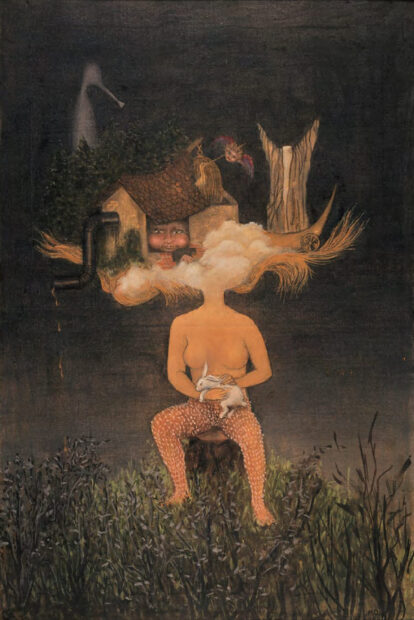
Meret Oppenheim, “Some of the Uncounted Faces of Beauty,” 1942, oil on canvas. 31 7/8 × 21 1/4 inches (81 × 54 cm). Private collection. Photo: Gerhard Howald, Kirchlindach, Bern © 2021, ProLitteris, Zurich
The stylistic developments Oppenheim made in the Genevieve painting spill over into one of the most original works in the room, Some of the Uncounted Faces of Beauty. In this 1942 painting, the artist has taken elements of her other pictures to create her own world. In it, a non-gendered figure with breasts is holding and petting a rabbit. On the figure’s head, which is dissolving into clouds, is a house with a leaking stovepipe; a cherub being skewered by a caged, long-beaked bird; and a tree-looking object sitting on a wheeled cart. The piece feels identity-less and discombobulated — an apt parallel to how Oppenheim’s world likely felt at the time. Paris had fallen to the Nazis in the summer of 1940, and the artist must have been coming to terms with the possibilities of a new European reality.

Meret Oppenheim, “Genevieve Hovering over the Water (Genoveva über dem Wasser schwebend),” 1957, oil on fiberboard, 14 3/8 × 18 1/2 inches (36.5 × 47 cm). Collection of Foster Goldstrom. © Artists Rights Society (ARS), New York / Pro Litteris, Zurich
Artistically, Oppenheim was unproductive during the war period; she made few pieces, and destroyed some of her earlier works. The third gallery of the show, however, charts her reemergence. She settled into a studio in Bern, Switzerland in 1954 and began to make work anew. Yes, there are still oil paintings from this period, but they don’t stick to her pre-war magical style. Instead, they are akin to Genevieve Hovering Over the Water, a 1957 painting that eschews representation in favor of allusion. Nearly 20 years after depicting the suffering woman floating above a village, here she has stripped the story down to its bare bones: Genevieve is a black mass, and the sea an impastoed spray of white. Oppenheim has already shown that she can paint; now, she is going to explore.
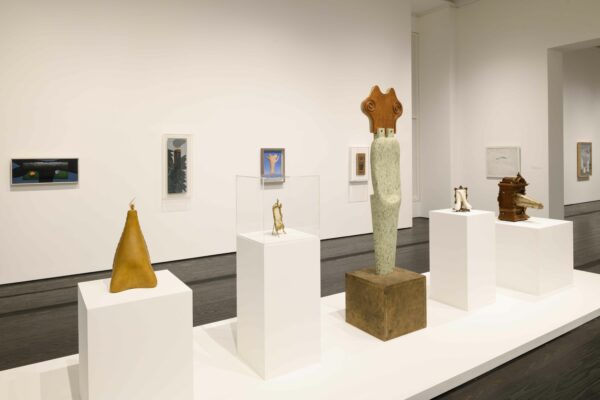
Installation view of “Meret Oppenheim: My Exhibition” at the Menil Collection, Houston. Photo by Paul Hester
Other works in the room more pointedly mark Oppenheim’s progression toward conceptualism. In them, we see the introduction (and mastery) of new materials — plaster, ceramic, limewood, copper, and other, found objects are combined to great effect. A display of five sculptures takes center stage, each with their own personality. Animal-Headed Demon (1961) features a Neoclassical clock case whose face has been impaled by a piece of wood; Miss Gardenia (1962) is comprised of a molded plaster protrusion, which has been sculpted to seamlessly compliment an ornate, metal frame. In a third sculpture, A Distant Relative (1966), sagging breasts and a pointed phallus spill out of a bronzed iron frame, resting neatly in the frame’s stand.
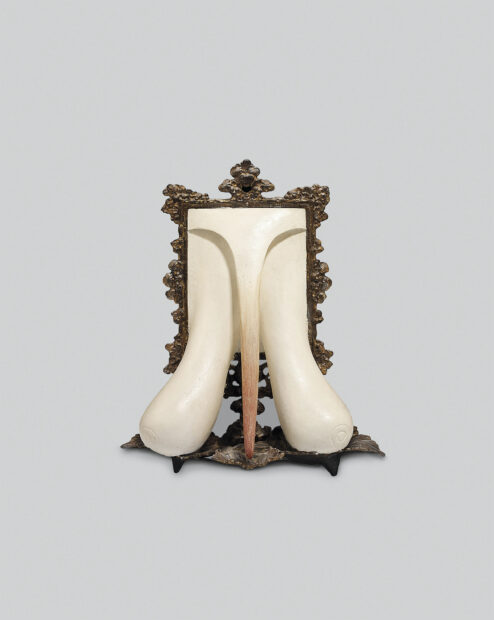
Meret Oppenheim, “A Distant Relative (Eine entfernte Verwandte),” 1966, molded substance (Rugosit) in bronzed iron frame, 10 5/8 × 9 1/16 × 6 5/16 inches (27 × 23 × 16 cm). Klewan Collection. © Artists Rights Society (ARS), New York / Pro Litteris, Zurich
In this return to object making, we see a playfulness reemerge from Oppenheim’s work. Sexuality, and the idea of the gray area therein, also becomes a more overt topic, particularly in A Distant Relative. As Nina Zimmer notes in her catalog essay: “This ambiguous sexuality is of a piece with Oppenheim’s thinking at the time. She frequently argued against rigid distinctions between gendered identities and advocated accentuating the masculine facets of femininity and the feminine facets of masculinity.”
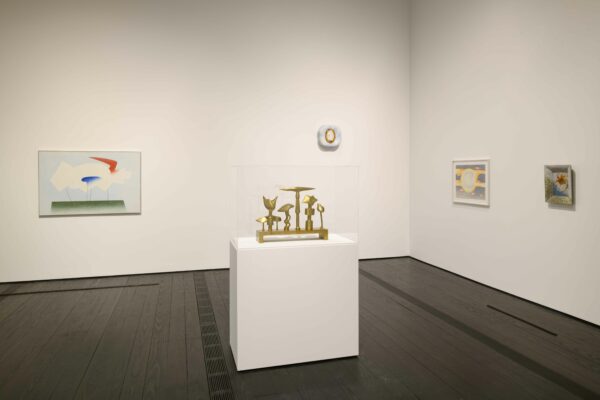
Installation view of “Meret Oppenheim: My Exhibition” at the Menil Collection, Houston. Photo by Paul Hester
At the same time Oppenheim was looking for found materials to alter, she was also creating art about looking up. The fourth gallery is loosely based on her paintings and sculptures of and about clouds, which she made in the early 1960s. The palette of these works is light and airy — blues, grays, and whites bring the compositions to life, a stark departure from the dark, brooding scenes and characters that filled her oil paintings in the war years.

Meret Oppenheim, “Cloud on a Boat (Wolke auf einem Schiff),” 1963, plaster and paint, 14 9/16 × 13 × 4 3/4 inches (37 × 33 × 12.1 cm). San Francisco Museum of Modern Art. Gift of David A. Kaplan. © Artists Rights Society (ARS), New York / Pro Litteris, Zurich
The most powerful of these works are her in-the-round sculptures, including Cloud on a Boat and Cloud on a Bridge (both 1963), which have the aura of modernist monoliths made anew. Her painted, curving shapes, which she formed using plaster, wood, and another substrate, feel like they’re more than they let on. Her titles mention boats, bridges, and clouds, but the sculptures also give off an alien, trophy-like quality. In this way, the works share similarities with real-world clouds: look up and, depending on who and where you are, you’ll see something different than your neighbor. Physically, the sculptures give off a cool, supple harness; the fact that they’re perfectly pedestal-sized and have smooth surfaces makes you want to pick them up and caress them.
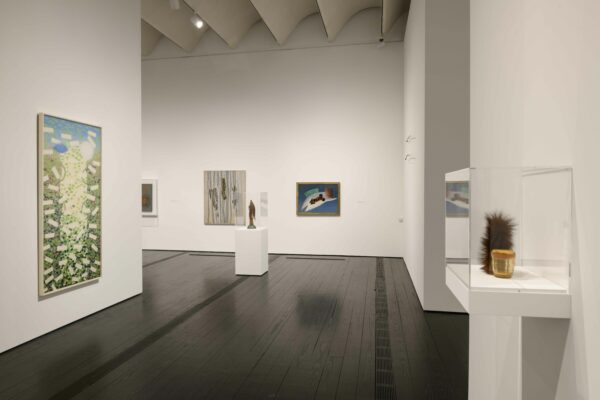
Installation view of “Meret Oppenheim: My Exhibition” at the Menil Collection, Houston. Photo by Paul Hester
The exhibition’s next gallery opens into a wide variety of work, including large-scale paintings, sculptures, collages, and editions. Along one wall is a selection of four collages that incorporate various types of papers, films, and drawing implements. One piece, Mask (1971), features images of peacock feathers, a flower, and a yellow spider, all on wood-imitation paper. Together, the elements form an anthropomorphic face, which gazes out blankly at the viewer. This faux-wood paper appears in some of Oppenheim’s pieces executed ten years earlier, and seems to be an ongoing base the artist employs to create a panel-like feeling for her works. In Mask, the effect is twofold: it ups the importance of the piece, since it appears to be on wood, and it also serves in place of the sculpted material of a real mask.

Installation view of “Meret Oppenheim: My Exhibition” at the Menil Collection, Houston. Photo by Paul Hester
Although a carved limewood mask by Oppenheim is included in the exhibition (Mask, 1959), the show does not feature four other masks, which were part of the exhibition’s Bern iteration. This work on paper, then, while also being a prime example of Oppenheim’s ability to effectively collage found materials, acts as a stand-in for the artist’s other mask works. The talent behind collaging and mask-making is one in the same, as Natalie Dupêcher notes in the show’s catalog: “Mask construction thus became the vehicle for Oppenheim’s passion for assemblage and found-art materials, offering the possibility of transformation not only of quotidian ‘stuff’ into personal adornment but also of its wearer.”
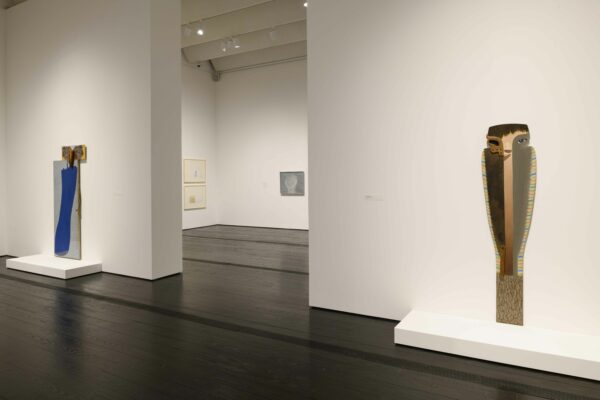
Installation view of “Meret Oppenheim: My Exhibition” at the Menil Collection, Houston. Photo by Paul Hester
Other pieces in the gallery highlight how far the artist’s assemblage eye has come. Two of these sculptures, Hm-hm and Octavia (both 1969), act as sentinels, guarding the doorway to the exhibition’s final gallery. Playing with a sort of tromp l’oeil, each work has painted and collaged elements that together make up the body and appendages of a single figure.
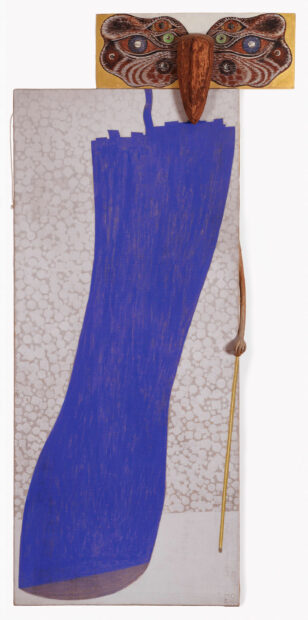
Meret Oppenheim, “Hm-hm,” 1969, acrylic on canvas; oil and gold leaf on wood; bark; and carved wood, 6 feet 6 ¼ inches x 37 3/8 x 3 9/16 inches (200 x 95 x 9 cm). Private collection, Bern. © Artists Rights Society (ARS), New York / Pro Litteris, Zurich
Hm-hm is more stoic, its wooden hand emerging from behind the canvas to clutch a painted, yellow cane. Octavia, by contrast, is playful. A sculpted tongue reaches out to lick the top of the blade of a saw, which is collaged onto the left side of the figure. Light gray paint has been applied under the object, mimicking a shadow cast by its teeth. The mirror outline of the saw is drawn on the right side of the figure, a painted eye occupying its handle hole. There’s a dangerous sensuality that exudes from this piece, and a viewer’s reading of it can vary; according to the show’s catalog, one critic thought the work “embodies fear of castration.”
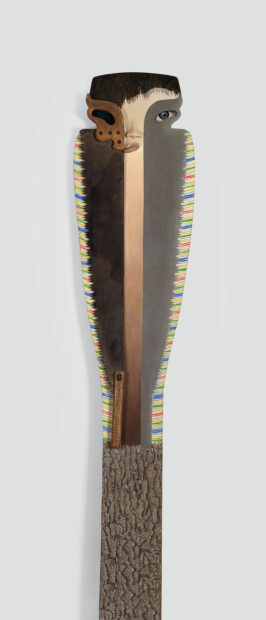
Meret Oppenheim, “Octavia (Oktavia),” 1969, oil on wood and molded substance with saw, 73 5/8 × 18 1/2 × 1 9/16 inches (187 × 47 × 4 cm). Private collection, Bern. © Artists Rights Society (ARS), New York / Pro Litteris, Zurich
The elements of Dada (found objects) and Surrealism (a nebulous figure and confused, dangerous sexuality) in Octavia fuse in the piece’s kinship to the nouveaux réalisme movement. In Zimmer’s essay, she notes that “the majority of the artists [in the movement] were French or Swiss, and Oppenheim felt at home among them; she was close to the group’s central members, including Niki de Saint Phalle, Jean Tinguely, and Daniel Spoerri.” Oppenhiem’s association with this movement is just one data point in the ever-evolving through line in recently organized exhibitions — to this point, the Menil co-organized a show of Saint Phalle’s work last fall.

Meret Oppenheim, “Schoolgirl’s Notebook (Le Cahier d’une Écolière),” 1930/1973, etching on paper, embossed and printed in rust, gray, green, and black; original blue paper-covered stiff wrappers, 11 x 8 ½ inches (closed), Edition 41/100. NMWA; Gift of Thomas Hill in memory of Rosemary Furtak. Photograph by Lee Stalsworth, image courtesy of Lisa Wenger and Martin A. Bühler, Meret Oppenheim Estate
The last gallery of My Exhibition acts as a landing pad for visitors preparing to leave the show. There’s a sort of recapping of Oppenhiem’s grand artistic vision, expressed by Schoolgirl’s Notebook, a piece from 1930 (originally made when the artist was 16) that was remade 43 years later as an etching and stencil print. In the work, Oppenheim riffs off of the “solve for X” math problems students receive as school assignments. She finds that X equals rabbit, an absurdist, funny conclusion that turns the problem on its head. This is also an example of the artist’s career-long penchant for revisiting and rehashing earlier ideas.
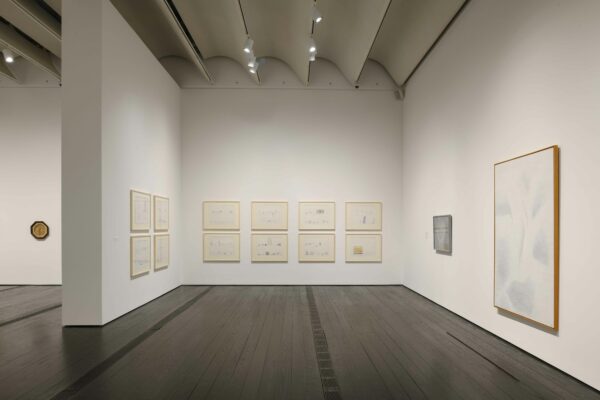
Installation view of “Meret Oppenheim: My Exhibition” at the Menil Collection, Houston. Photo by Paul Hester
Two paintings in the room, Head of Fog and Flower of Fog (both 1974), show us that Oppenhim has finally let her subjects drift all the way up into the clouds. In these works, although her forms are visible, they’re greatly obscured. Flower of Fog, which is one of the artist’s larger paintings, clocking in at over 6 by 4 feet, feels like a rounding off of Oppenheim’s painting output: she went from surreal, dark, and twisted scenes inspired by the unknown and the ravages of war to a light, airy close-up landscape that’s concerned with feeling and immersion just as much as it is with painting technique.
Capping off this final room is M.O.: My Exhibition, a series of twelve drawings in which Oppenheim plans out an ideal version of her career retrospective. These works were created, according to the show’s catalog, “in anticipation of a major retrospective of her work, scheduled to open in September of 1984 at Kunsthalle Bern.” On the first drawing of the series, Oppenheim writes that while this is her version of a show, it is “only an example” of what the exhibition could be, saying “I had to leave aside many works that for me are no less important.”
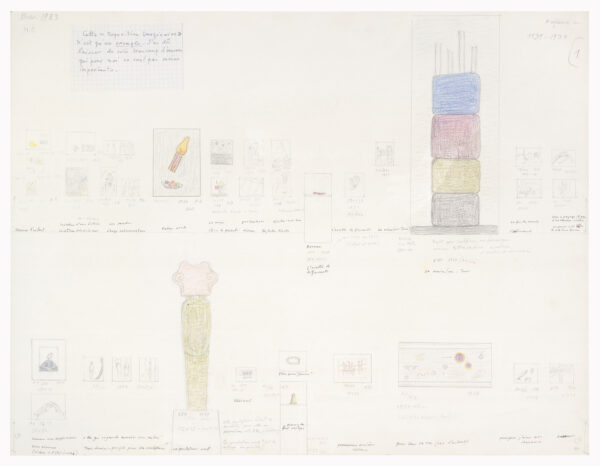
Meret Oppenheim, “M.O.: My Exhibition (M.O.: Mon Exposition),” 1983, pencil, colored pencil, and ballpoint pen on paper, 25 1/2 x 19 11/16 inches (64.8 x 50 cm). Bürgi Collection, Bern. © Artists Rights Society (ARS), New York / Pro Litteris, Zurich
While the piece has many enjoyable moments of discovery — it turns out her fur teacup is indeed on view, just as a micro drawing — it is also a perfect finale. The work practically hits you over the head with Oppenheim’s personality: she’s someone who knows her craft, someone who has strong opinions about her own work, and someone who cares about how people perceive what she’s done. Even though she admits these drawings are not a be-all and end-all exhibition, she’s willing to speak up and tell you what her show, if she had to pick, would be.
Walking out of My Exhibition, visitors encounter New Stars, an oil painting the artist made between 1977-1982. The work is hung in the Menil’s long hallway, outside of the show’s proper galleries. Fittingly, the painting is the only piece illustrated in the twelfth panel of Oppenheim’s fantasy exhibition drawing, alone because of its large scale. In her 1984 exhibition, this piece was hung exceedingly high on a wall above a doorway — lofty, aspirational, out of reach, and dreamlike.

Meret Oppenheim, “New Stars (Neue Sterne),” 1977–82, oil on canvas, 6 feet 8 11/16 inches x 8 feet 1 13/16 inches (205 x 248.5 cm). Kunstmuseum Bern. Meret Oppenheim Bequest. © Artists Rights Society (ARS), New York / Pro Litteris, Zurich
I’m a fan of the painting’s placement here in Houston; the piece is both a hello and a goodbye, giving visitors a peek of what’s to come in the show’s later hours, and then acting as a final look for those leaving. It completes the circle of the artist’s career in a wonderful and unexpected way: instead of being greeted by intimidatingly large wall texts or graphics of the artist and her work (this isn’t the Menil’s style anyway, but I digress), the entrance and exit is simple, clean, and thoughtful. There’s no fur in sight. When thinking about how the artist looked at and assessed her own career and how she wanted to be her own artist and person, this work’s placement, in relation to the rest of the exhibition, makes perfect sense. It’s what Oppenheim would’ve wanted.
Meret Oppenheim: My Exhibition is on view at the Menil Collection in Houston through September 18, 2022.



1 comment
So glad I was able to see this before it is/was taken down. I appreciated the opportunity to share some intimate moments with a large part of her oeuvre. It was a revelation!